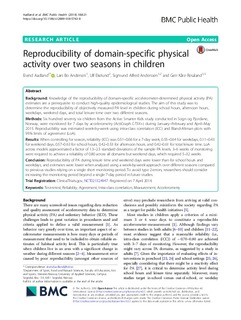Reproducibility of domain-specific physical activity over two seasons in children
Journal article, Peer reviewed
Published version

Permanent lenke
http://hdl.handle.net/11250/2579455Utgivelsesdato
2018Metadata
Vis full innførselSamlinger
- Artikler / Articles [2119]
- Publikasjoner fra Cristin [1107]
Sammendrag
Background: Knowledge of the reproducibility of domain-specific accelerometer-determined physical activity (PA) estimates are a prerequisite to conduct high-quality epidemiological studies. The aim of this study was to determine the reproducibility of objectively measured PA level in children during school hours, afternoon hours, weekdays, weekend days, and total leisure time over two different seasons.
Methods: Six hundred seventy six children from the Active Smarter Kids study conducted in Sogn og Fjordane, Norway, were monitored for 7 days by accelerometry (ActiGraph GT3X+) during January–February and April–May 2015. Reproducibility was estimated week-by-week using intra-class correlation (ICC) and Bland-Altman plots with 95% limits of agreement (LoA).
Results: When controlling for season, reliability (ICC) was 0.51–0.66 for a 7-day week, 0.55–0.64 for weekdays, 0.11–0.43 for weekend days, 0.57–0.63 for school hours, 0.42–0.53 for afternoon hours, and 0.42–0.61 for total leisure time. LoA across models approximated a factor of 1.3–2.5 standard deviations of the sample PA levels. 3–6 weeks of monitoring were required to achieve a reliability of 0.80 across all domains but weekend days, which required 5–32 weeks.
Conclusion: Reproducibility of PA during leisure time and weekend days were lower than for school hours and weekdays, and estimates were lower when analyzed using a week-by-week approach over different seasons compared to previous studies relying on a single short monitoring period. To avoid type 2-errors, researchers should consider increasing the monitoring period beyond a single 7-day period in future studies.